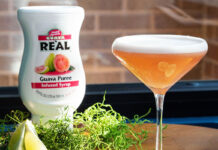Keep on top of evolving category
Long gone are days when a G&T meant an optic measure and a gun dash, and as 2016 comes to a close it seems clear that the gin category has real staying power as a top seller in the Scottish on-trade.

With more brands continuing to roll out seemingly on a weekly basis and customers expecting a certain level of knowledge from bartenders, a number of gin producers have offered their advice on how operators can keep on top of one of the fastest evolving categories in the trade.
Tina Connolly of Halewood Wines & Spirits, the firm behind Whitley Neill Gin, reckons customers “are becoming more curious and adventurous in discovering their favoured gin” and part of the credit for this can be attributed to the UK gin production boom.
“Its quintessentially British roots really appeal to those seeking a spirit with a story and this, along with its packaging and drinking experience, is equally important as the product itself,” said Connolly.
This enthusiasm breeds knowledge, Connolly reckons, and as customers become familiar with the category licensees should expect to see sales of premium brands grow.
“Consumers, more than ever, really ‘know’ their gin and they’re driving both premium and super-premium growth,” said Connolly.
Paul Miller, founder of Eden Mill, agreed that strong gin knowledge can help drive sales and operators should take advantage of this.
“Understanding gin as a product itself can help,” said Miller.
“There are many undifferentiated gins out there.
“The consumer is thirsty for gin and hungry for product understanding, in equal measure.
“They are also promiscuous and like to try different products.”
An increased thirst for knowledge among customers has certainly given on-trade staff plenty to get to grips with, but Miller also reckons a well constructed drinks menu can carry a lot of this burden and help staff promote more premium products.
It won’t hurt to have jars of botanical examples to hand.
“Gin menus explaining the different gin making methods, authenticity of production and rationale for the various botanical recipes are helpful,” he said.
“These can be used to up-sell and to encourage consumer trial.”
There’s unquestionably a lot to learn for the gin novice and Sian Buchan, brand ambassador for Caorunn Gin, suggests operators head out to sample new products themselves.
“Go to as many trade shows or tastings as possible so that you can try the products and ensure excellent quality for your customers,” she said.
“Also, once you have a product in, find out if the brand has any kind of training available to you as there is likely to be someone available to talk to your staff and show that product in its best way so that staff can then talk about it or show it off with confidence to your customers.”
Even the most knowledgeable staff members are unlikely to have an answer to every question a clued-up customer may ask – especially with interest so high.
When it comes to tackling tricky questions, Buchan reckons honesty is the best policy.
“Be open and honest,” she said.
“Consumers know much more than ever before so if you’re asked a question that you’re not sure about, say that and say you’ll find out and get back to them rather than make something up or lie.”
The scale of the task faced by bartenders when it comes to gin knowledge was not lost on Leah Shaw Hawkins of Pickering’s Gin, but there are shortcuts and solutions at hand.
“Botanicals can be baffling, and lengthy lists are rarely worth learning in their entirety – depending on the spirit they can often be pretty difficult to detect on the nose and palate,” said Shaw Hawkins.
“It won’t hurt to have a few little jam jars of botanical examples to hand – maybe think about picking up some juniper berries, cardamom pods, angelica/orris root, etc.
“Having examples of some of the main flavour groups found in gin (floral, spice, citrus, bitter) to hand will really help gin fans, and hospitality teams, make the connection between the subtle notes they enjoy and where they come from.”
A flavour focus can certainly pay dividends at the bar according to the gin producers, but not every operator needs to bring in a world class mixologist to make hay from the gin boom.
James Shelbourne of Silent Pool reckons there’s still plenty of mileage in the G&T serve as a mechanism for exploring the vast selection of small-batch gins on offer at present.
“Improving the bottom line is about offering a range of styles and prices,” he said. “Offering G&T menus isn’t original but they work – particularly where varied garnishes are added.
“[They are] simple to execute (you don’t need a cocktail bar person) and value-added – so a surcharge on a standard G&T.”
Gin and tonic may be the biggest juniper spirit serve in the on-trade, but it’s not for everyone.
Simon Fairclough, distiller of Persie Gin, said he finds that “people who don’t like tonic tend to have a sweeter tooth” and offered some suggestions for getting these customers into gin.
“If this is the case, we would steer them towards a gin liqueur and serve it over ice – or with Prosecco or a ginger-based premium lemonade,” said Fairclough.
“Bitter lemon is also cropping up more often these days and is suited best to full-bodied fruity gins.
“We also find ginger ale a terrific mixer for slightly sweeter gins such as an Old Tom, or spicier gins with a cinnamon or cassia base.
“The trick is getting the balance right between the gin botanicals and the mixer.”




















